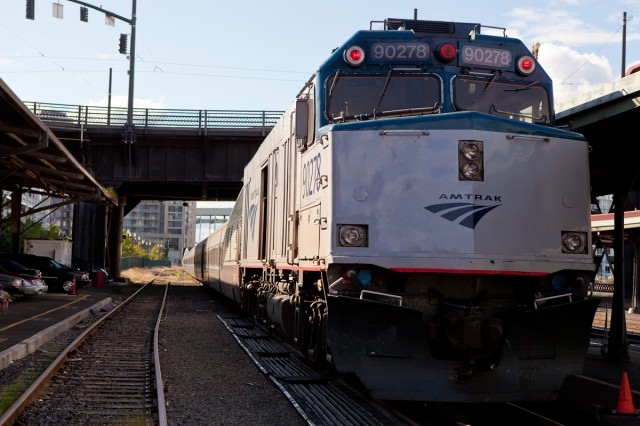
About ready to head north on the Amtrak Cascades. Photo by Jeremy Dwyer-Lindgren / NYCAviation.com.
Jeremy Dwyer-Lindgren, with NYCAviation.com, recently took an Amtrak train ride from Portland to Seattle and wrote a review to compare the experience to a flight. Here is his review in his own words:
AMTRAK REVIEW
Cheers: On-time, spacious, crazy low price
Jeers: Equal to driving time; three times as long as a flight
Coming off the recent experience with a Superliner car on a Vancouver BC to Seattle trip, we had to admit expectations were high. To refresh, coach class seating on the trip involved a crazy amount of legroom, generous recline, and almost a full window of view for an exceptionally low price. We had wondered at first when boarding in Vancouver if we accidentally boarded the business class car by mistake and were pleasantly surprised to discover we had not. If coach class was that impressive, we figured that business class had to be damn near palatial.
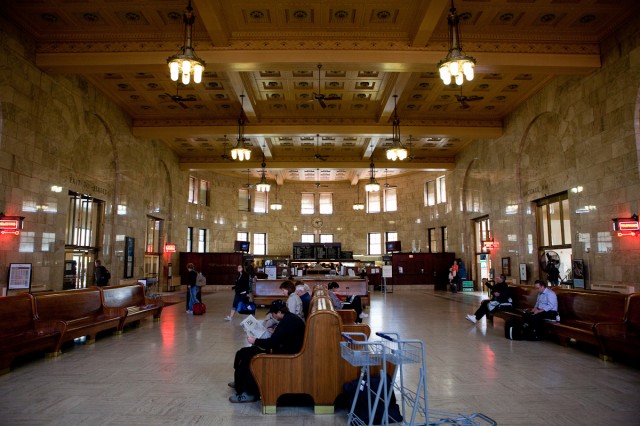
The train station in Portland. Image by Jeremy Dwyer-Lindgren / NYCAviation.com.
So you can imagine our surprise when taking advantage of priority boarding to car oneexclusively business classand discovering that the legroom we expected to be a sea of freedom ended up being about equal to the exit row on your average 737.
Curses.
But alas, we discovered we were set up. See, apparently the BC cars were an aberration. Normally the route utilizes the ones we were now looking atTalgo IV articulated tiltedbut we had a substitute from the usual cars the day we traveled from BC; the double-decked Superliner, which is normally only used on long-haul routes like Chicago to LA’s Southwest Chief. Because the Superliner is built for long-haul days-on-end trans-cons, coach class is built to enable someone to comfortably call that seat home for long periods of time. The Talgo car we were on, again the usual cars for this route, was built for high-speed. The train set can travel up to 110 but is limited to 79mph by safety restrictions.
Still though, first impressions can be deceiving and we settled into seat 7C in the 2-1 configured cabin. Fresh from an assignment that ended only an hour earlier, we set up right away to get to work while the train pulled away from Portland’s Union Station on time. The massive laptop came out right away. A meal tray easily unlatched and set itself a comfortable distance away, large enough to handle the behemoth computer. Between the wide seat width and sitting along the aisle we did not feel cramped: there was enough room to juggle our laptop, iPad, camera, and paperwork without too much trouble.
Work-space comfort? Check.
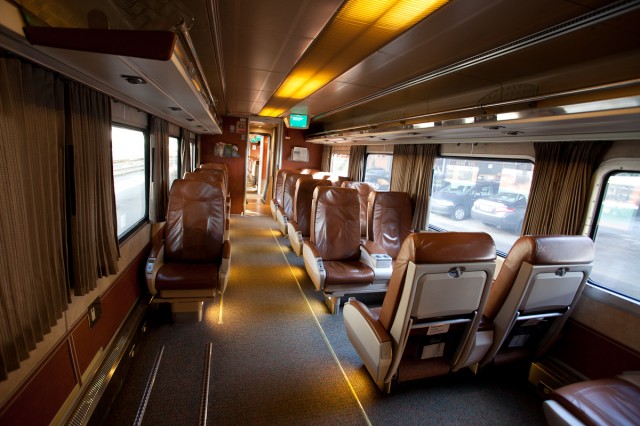
Amtrak Cascades Business Class cabin. Image by Jeremy Dwyer-Lindgren / NYCAviation.com.
Thanks to needing to run some high-powered photo editing software, it desperately needed some juice. No worries though, as there is a plug right there by our feet along the floor.
Power? Check.
Finally, we very much needed to catch up on some email and otherwise utilize the world-wide web. While Amtrak’s free WiFi service is much maligned and apparently notorious for being awful, the service ran largely without issue the entire trip. A few hiccups through tunnels and again when trying to attach several large files were the only times that the service stopped or slowed at all.
Connectivity? Check.
The combination of spatial comfort, constant power, and consistent connectivity made getting work done on board a real breeze.
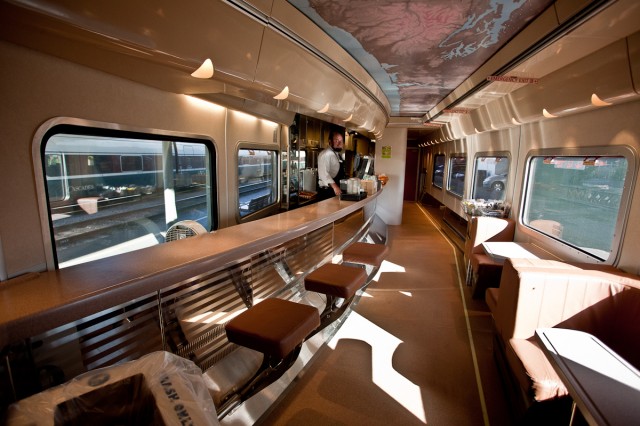
Inside the Dining car on the Amtrak Cascades. Notice the ceiling. Image by Jeremy Dwyer-Lindgren.
Halfway through the trip, somewhere around Centralia WA, we took the opportunity to visit the dining car and grab some grub. We ordered a cheeseburger ($6) with a bottle of orange juice ($2.50). The burger, which was heated via microwave, was pretty good. It was not the same as ordering from a decent restaurant or cooking on your grill at home, but it was fairly large and filling. The orange juice was, well, orange juice: pretty self-explanatory. Thanks to a $3 coupon given to the folks with a biz class ticket, the final bill came out to $5.50: not bad and cheaper than most airline meals.
The dining car itself is pretty nice, reflecting that these particular train sets are relatively new by Amtrak standards. They were introduced to the stock in the mid 90s and serve exclusively on the Cascades route. The ceiling bears tiny lights that we imagine were stars and featured a map of the route. The overall aesthetic was inviting, featuring a flowing bar-style counter and a number of booths. While we were there, the car was mostly empty. There was another passenger nursing a beer and a conductor taking a break.
Getting back to our seat, we finally had time to enjoy the experience more fully. With the comfortable leather seat fully reclined (estimated 8 inches or so), we caught a brief cat nap before spending the rest of the trip soaking in the seriously stunning scenery whizzing by out the window. Our train, scheduled to arrive at Seattle’s King St Station at 2145, pulled in early at 2130.
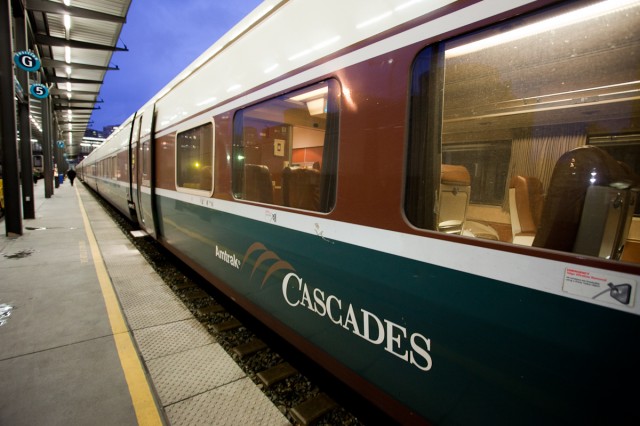
Amtrak Cascades car taken in Seattle. Photo by Jeremy Dwyer-Lindgren / NYCAviation.com.
The trip was very enjoyable overall: food was reasonable and priced well, the seat was relaxing and comfortable, space sufficient to accommodate work and relaxation; all while arriving ahead of schedule. That being said, we are unsure if upgrading to business class was entirely worthwhile. We had intended to compare and contrast against our BC-Seattle trip, but given how different they were that no longer seems fair.
What we can say is that coach class is configured in a still generous 2-2 layout, with some sections having family style seating. WiFi and power outlets are standard. The recline was still more than your average airline coach recline, and legroom not that much less than in business. Coach was pretty full and fairly loud while business was about 50% full and very quiet. Given that the upgrade cost a measly $16 ($13 after applying a $3 AAA discount), resulting in a $42 total ticket price, the upgrade definitely seemed like a better deal.
And of course you receive many of the other benefits of train travel: no crazy invasive TSA security, no hours stuck behind the wheel waiting for a car wreck to clear, more space and comfort, and the ability to sit back, relax and let the world pass you by.
[nggallery id=5]
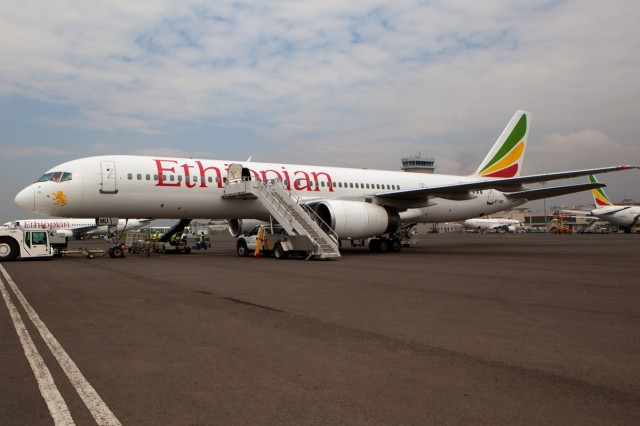
Ethiopian Airlines Boeing 757-200 at Addis' Bole International Airport. Photo by Jeremy Dwyer-Lindgren / NYCAviation.
Previously I shared a review of Ethiopian Airline’s Cloud Nine Business class, written by Jeremy Dwyer-Lindgren for NYCAviation.com. This is his second review, which looks at Ethopian’s economy class. Here is his review in his own words…
WASHINGTON DC: Four flights, forty-four hours of flying, and one day trip to Ethiopian Airlines headquarters in Addis Ababa later, NYCAviation (NYCA) has one good story ready to roll. Over the course of the next month, NYCA will be debuting a three part series focusing on the Ethiopian carrier; their in-flight service, their history, and their future. We hope you’ll join us for the adventure!
The first in the three part series, NYCA reviews the in-flight experience in the economy cabin on board Jo’Burg to Addis and Addis Ababa to Dulles flights. Both flights were inaugurated during the mid to late 1990s as part of an aggressive expansion of their international service surrounding their 50 year anniversary (1996 and 1998, respectively). Ethiopian provided the flights to NYCA at no charge, flying both legs in September 2011.
Part I Jo’Burg to Addis
Ethiopian Airlines Flight 808 Service to Addis Ababa from Johannesburg
Boeing 757-200 ET-AMT or AMU
Dep: 1438/SAST Arr: 2030/EAT
Seat 15A: Economy Class
Having been dropped off from a previous flight in the domestic terminal in Johannesburg, finding the international check in desks was a bit of a chore. Once located, the line had built up to a forty minute wait, despite not having a bag to check.
Once ticketed, customs and security were both very straightforward and easy. The inbound flight from Addis was running late, and I spotted an Ethiopian Boeing 757, not the listed Boeing 767, rolling to a stop on the runway about twenty minutes prior to boarding time. Nevertheless, boarding began only eight minutes late at 1348 local time, and I settled into 15A for the five hour flight north to Addis Ababa. My carry-on has no problem finding a home, and the camera comes out for departure. The 757 being the performer that it is, we rocket nicely out of Johannesburg about 32 minutes behind schedule.
Considering the 757’s are some of the older aircraft in a fleet that is otherwise unusually young, the quality of the cabin is remarkably good. All the economy seats are (p)leather clad and comfortable enough for economy. They recline a workable 32 degrees of pitch and feature a built in remote in the armrest for selections of music or movies. However, it was odd that the armrest did not lie flush with the seat when not reclined. It stuck out a healthy amount, enough so that if you were lucky enough to have a seat vacant next to you (as I did) it becomes hard to stretch out without getting poked by it.
This particular aircraft was not outfitted with personal TV’s but did have the screens that are fixed to the cabin ceiling. The programming began about 45 minutes in with the smaller shows through dinner culminating to the movie about three hours in.
A meal & drink service began about an hour into the flight presenting options of chicken or fish. The meal consisted of chicken breast with a tomato sauce, rice and carrots. A roll with butter, crackers & block of cheddar cheese, salad with Greek dressing, and packaged desert of coconut cheesecake with berry sauce complimented the main dish. Overall it was a serious step up from anything you’d get domestically in the US nowadays, but it was not ultra fantastic either. It was satisfying, filling, warm & good. The meal was followed up by traditional post meal coffee and tea service. Trays were cleared about an hour following dinner, which appeared problematic for many of the other passengers, since most were done within twenty minutes.
While not watching the movie most of the flight was spent sleeping or talking up the staff in the rear galley. Speaking of the staff, there were some noteworthy exchanges. For the first, I attempted to inform a flight attendant, who throughout the whole flight never gave the impression that she was thrilled to be on board, that one of the lavatories had an issue needing attention ’“ I never received a response. On the flip side, I had some questions about how customs and the process in general worked once arriving in Addis. I inquired in the rear galley and all three flight attendants were extremely helpful in answering each and every question in addition to pouring me a few drinks. The one attendant aside, the staff met or exceeded expectations for friendliness and professionalism. I wish I had more pictures from this flight, but unfortunately the vibe was not right for it, so the camera stayed put away through most of it.
Despite the late departure we made up the time in the air and ended up landing ten minutes early; a nice surprise. After waiting for Cloud Nine business class passengers to vacate, we de-boarded via the air stairs and onto large busses that took us the short distance to the terminal.
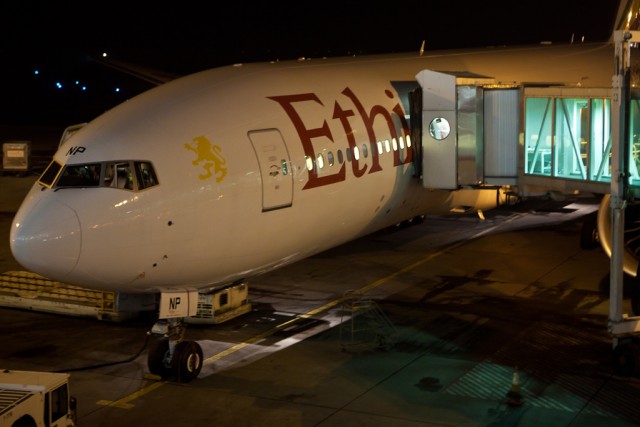
Ethiopian Boeing 777 in Addis. Photo by Jeremy Dwyer-Lindgren / NYCAviation.
Part II Addis to Washington Dulles ’“ Via Rome
Ethiopian Airlines Flight 500 Service to Washington Dulles from Addis Ababa via Rome
Boeing 777-200LR ET-ANO
Dep: 2227/EAT Arr: 0300/CEST // Dep: 0801 Arr: 1117
Seat 23A: Economy Class
Arriving at the ticket counter around seven at night after a long day, it was relieving to see a ticket counter dedicated solely to the flight. Check-in was smooth and fast, with customs and security following the pattern. At 2130 the flight begins to board, and twenty minutes later I settle into 23A for seventeen hours aboard the brand-spanking new Boeing 777-200LR (ET-ANO). Despite a scheduled departure of 2205, we did not end up pushing from the gate until 2216, with wheels up for Rome at 2227. Twenty minutes is not the end of the world though, and we predictably made it up en route while trekking over Sudan, Egypt, and the Mediterranean.
Much like the prior flight from Addis to Jo’berg, the first meal service promptly began about an hour in. We were offered choices of chicken, beef, or fish. I chose chicken. It was bathed in a cream sauce along with rice and carrots. A side salad, crackers & cheese, and a roll with butter were also provided. The meal was of average quality and filling. It might have been better – or I might have been a better judge – had I not had a nasty head cold that developed from the day before. As a result, my sense of taste was not in its best form.
While waiting for the dinner tray to be cleared I spent some time playing BlackJack on the 777’s seat back entertainment system. It was clear that Lady Luck was not with me, as I burned through my 1000 in fake money in what may have been a new airline record. Shortly after, while starting a movie, the entertainment system froze and then shut down completely. My seatmate had the same problem, and flagged down a flight attendant who attempted to rectify the problem. About thirty minutes later the system restarts and is fine for the remainder of the flight. Most of the rest of the first leg is spent asleep.
We touched down in Rome almost twenty-five minutes ahead of schedule at 0300. A short taxi later we’re in position on a remote ramp for a refuel. Most of the cabin is asleep, watching a movie or reading a book, and no one seems to notice that the hour scheduled stop has come and gone. About ninety minutes into the stop the pilot announces that we’re still taking on fuel and it’ll be another hour: plus some tires have ’œlow pressure’ and need to be replaced. Frankly this sounds fishy to me, low pressure in the tires does not normally require replacement unless they were totally flat, but maintenance is what it is and at this point complaining is not going to get me off any faster. Another hour later the jack for the tires arrives and it is not large enough. The correct one does not arrive for another ninety minutes or so. By the time the plane has been refueled (twice by the pilot’s record) and fixed up with new tires the stop in Rome lasts just over five hours: No fun.
That being said, the airline and the flight crew did a great job of making an unfortunate situation tolerable. Consider: the plane was kept cool, powered, and the entertainment functional the entire five hours. The crew completed a meal service (I’m told it was breakfast, feeling pretty awful I slept through it), and offered drinks the whole time. And they kept smiling to boot ’“ impressive. We finally set off for Rome four hours behind schedule, with wheels up at 0801 local time.
Cutting to the product itself, the seat-back entertainment is quite nice. The on-demand offerings ranged from TV to games, flight maps to movies. The screen can be operated by touch or by a remote built into the armrest. The seat reclines to 32’ of pitch, and also pushes out to decrease the amount of recline into the person behind you’s space. The plus side is the passenger in front of you takes up less of your space’¦the downside is you reduce your leg room by pushing the seat out. The trade-off seems worthwhile to me.
The airplane being new (the average age of the 777 fleet is under one year), the cabin is predictably in great shape and the newness of the airplane impresses a lot of travelers. The 3-3-3 setup feels reasonably spacious, despite the cabin being full to the brim (287 folks on board).
The remaining nine and some change hours en route from Rome were largely spent sleeping and catching a few movies. Still feeling rather ill, I declined brunch except for a ginger ale, though the food of my seatmate appeared to be similar in nature to the late night dinner we had some twelve hours earlier.
We greased the runway at Dulles at 1117 local time and pulled up to the gate quickly. Deboarding was a bit chaotic, but with a little planning I ended up being first off those annoying Dulles customs shuttles, allowing for a quick sprint through customs and back into the good ole U S of A.
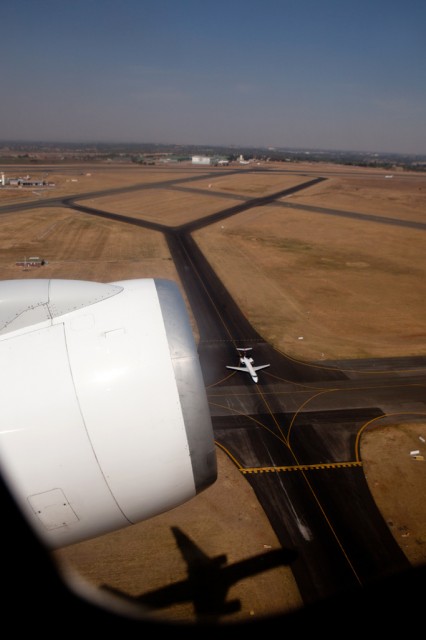
Departure out of Johannesburg. Photo by Jeremy Dwyer-Lindgren / NYCAviation.
Part III The Bottom Line
Regarding Flight 808 to Addis, it was a slightly above average economy experience. The service and staff were generally friendly and fast, the food was good, and the seat on par for an economy experience. Personal entertainment systems, like a seat back system, would have been a bonus, but the five hour flight is not terribly long: bring a book or an e-reader if you need some help passing time or utilize the in-flight entertainment. When compared against most US domestic economy sections, this flight comes out looking good. With the variance on plane types for the flight, you might even be treated to an oversized Boeing 767.
Moving on to Flight 500, let’s cut right to it: seventeen hours on an aluminum tube in coach is never going to be a picnic no matter the carrier. And even worse when an unexpected delay pushes it to twenty-one straight hours.
Addressing the delay, a five hour ground stop for fueling and tire replacement seemed excessive, but this is also a moment that forces an airline and a crew to show their true colors. In this respect Ethiopian met or exceeded expectations: they kept the plane powered & cool and the PTV’s running, they completed a food service, and they kept drinks available through the entire stopover; with a smile. What could have been a nightmare worth writing home over instead turned into an opportunity to show off the airline and crews ability to manage a stressful situation and make the best out of it.
The vast majority of the time, however, the flight will not experience a similar delay and by and large customers will find an enjoyable economy experience. Friendly service, plentiful & decent hot meals, and a well stocked entertainment system help the scheduled seventeen hour flight go by fast.
Overall, while other reviews online are not especially positive, this traveler had a markedly pleasant experience on both economy flights even with the five hour delay in Rome factored in. When you consider prices that the carrier has recently offering on the flights, it is an option that is hard to pass up. This author feels that most travelers will find themselves pleasantly surprised and that coach travelers can rest assured that they will be kept comfortable and well fed on board Ethiopian economy.
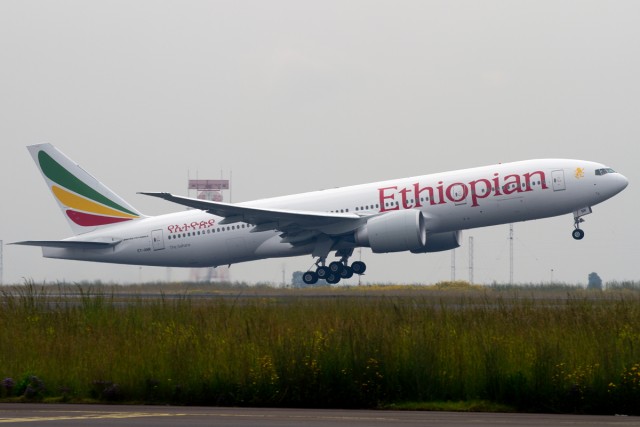
A Boeing 777-200LR takes off from Addis Ababa's Bole International Airport. Photo by Jeremy Dwyer-Lindgren / NYCAviation
Jeremy Dwyer-Lindgren, who works for the site NYCAviation.com, had the opportunity to fly on an Ethiopian Airlines business class flight on a Boeing 777 and 767. I thought the story was great and am able to share it with my readers. Here is his story in his own words:
ADDIS ABABA, ETHIOPIA: This is the second of a three part series on the airline, with this segment focusing on their business class service named Cloud Nine. NYCAviation (NYCA) had the opportunity to review this service on two international flights: Washington Dulles to Addis Ababa and Addis Ababa to Johannesburg. Ethiopian provided the flights to NYCA at no charge, flying on both legs in September 2011.
Part I Addis to DC
Ethiopian Airlines Flight 501 Service to Addis Ababa from Washington Dulles
Boeing 777’200LR ET’ANR
Dep: 1201/EDT Arr: 0738/EAT
Seat 03H / Cloud Nine Business Class
Stepping onto the curb in a rainy Washington DC, I made my way to the Ethiopian Airlines (ETH) counter, which is tucked in the back off to one side. Check’in was short and sweetabout 15 minutes start to finish. I took advantage of ETH’s two’checked’bags policy and left one bag in their care. At the ticket counter I had been assigned seat 20B, but at the gate I was upgraded to seat 03H in Cloud Nine.
Boarding was a breeze. Cloud Nine passengers, members of ShebaMiles and other preferred’status folks boarded first. I was the third person to walk onto the large, new Boeing 777’200LR (ET’ANR). Ethiopian’s business class on the B772 (the airline has no first class) is configured as 2’3’2, with 03H in the middle section on the aisle. As the passengers settled in before we departed on this 12+’hour flight, drinks ranging from juice to liquor and copies of Le Monde and The Washington Post were offered.
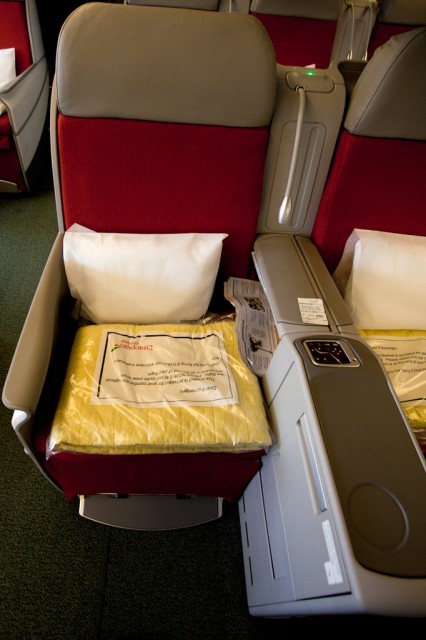
Cloud Nine Seat on the 777. Photo by Jeremy Dwyer-Lindgren / NYCAviation.
Dulles was unusually slow that day, which allowed a nearly on’time departure (about 10 minutes late) from Runway 33. A Saudi Arabian Airbus A340’300 and the ever’elusive Boeing 747SP on the remote ramp enhanced the view as the 777’s wonderfully massive GE’90 engines spooled up. We climbed out over the Washington Metro area and headed northeast.
Following an hour long power nap just after departure, I awoke to the sounds of drinks being served. A selection of juice, soda and top’shelf liquor was offered along with salted airplane shaped crackers. Lunch service followed shortly thereafter.
The hors d’oeuvres were sweet chili bay scallops, citrus’cured smoked salmon and sliced bresaola (air’dried beef) served with salad and warm bread and butter. The beef was spicy and good. I don’t eat fish or seafood and so passed up the other choices, but they looked excellent. A salad, also provided, was OK.
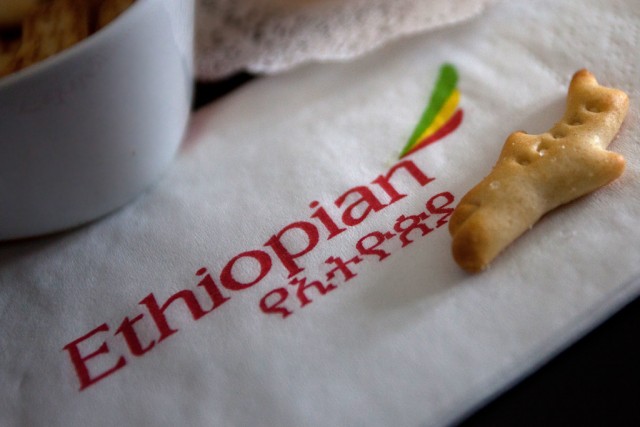
Little airplane crackers! Photo by Jeremy Dwyer-Lindgren / NYCAviation.
We were asked to choose an entre: beef, chicken, fish or vegetarian. I opted for the seasoned chicken breast with vegetables in teriyaki sauce and rice with asparagus. The meal was good and satisfyingthe chicken was tender and moist, the vegetables crisp and warm. It came with more bread and butter. After the meal, dessert ’ a slice of coconut cheesecake for me. Service was quick and friendly (perhaps too quick: While no one rushed me through a course, I couldn’t help but feel a bit hurried), and capped off by the traditional coffee service.
Four hours in the sun was already setting. While much of the cabin settled in for the night, I went for the entertainment system. A wide selection of TV and movies in multiple languages are available along with games, flight tracking maps and other options. The touch screen is large; 15.4 inches wide. With the screen nestled into the seat back in front of you it requires a stretch to reach, but the tethered remote takes care of that. The remote itself is a bit less intuitive than I would’ve liked, and at times it was easier to use the touch screen than fiddle with it. The airline provided a bagged set of their own headphones, which got the job done. During the flight I watched a few movies, some TV, and played BlackJack (a shame that it wasn’t with real money).
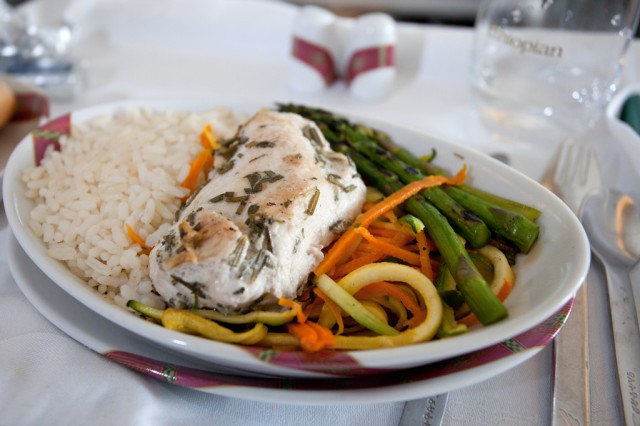
Tasty lunch service on the Ethiopian flight. Photo by Jeremy Dwyer-Lindgren / NYCAviation.
Sleep came shortly thereafter and I found myself able to manage about five hours of solid rest. Utilizing a shell based design the Cloud Nine seats are considered angled lie’flat and have a respectable 65 inches of pitch: they even has a massage function to help loosen up the muscles. The other details are pretty standard: a large, fold’out tray tucked into the side of the armrest, adjustable reading light, foot rest and a pillow & blanket set. The only downsides were lack of power outlets and the seat not being terribly private: an adjustable divider between the seats would have been welcome. Ethiopian’s one carry’on policy kept overhead space easily available.
While sleep was welcome and need, unfortunately I slept through the second meal service. According to my menu I missed out on a selection of culinary delights ranging from mini beef meatballs and chicken satay to mini pizza and jalapeno poppers. I trust that they matched the positive experience of the first meal service.
With two’and’a’half hours remaining the final meal service began: breakfast. Again the food was enjoyable and plentiful. There were a few options; I chose the cheese omelet with hash browns, chicken sausage and sauted mushroom with a grilled tomato ’ complimented by a fresh fruit salad and yogurt.
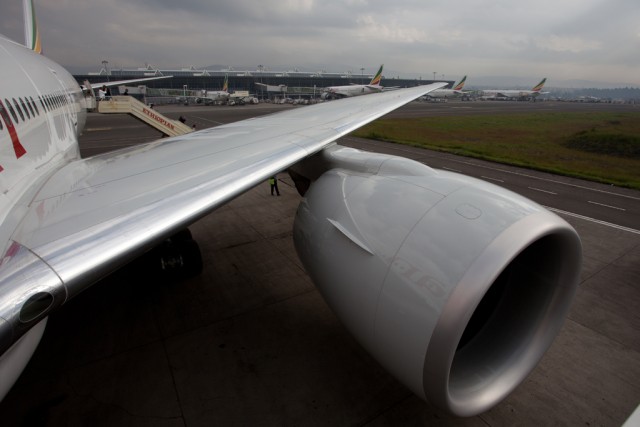
Deboarding in Addis Ababa. Photo by Jeremy Dwyer-Lindgren / NYCAviation.
As the flight neared arrival a stop to the lavatory to freshen up was in order. A packet of amenities, located in the seat, contained toothpaste and brush, comb, mouthwash, sleeping mask, and a handful of other items. Nothing to write home about, but after a long flight the ability to brush your teeth and comb your hair in the lav is welcome.
We landed early into Bole International Airport at 0738 local time. Taxi was fast and we quickly pulled up to a remote gate complete with air’stairs. Deboarding was quick and efficient as Cloud Nine was let out first, with a minibus exclusively for business class greeting us at the bottom of the steps. Once on the mini’bus we were whisked away to the terminal, which is a bit of a challenge to navigate the first time. Having a very short connection I was directed by staff up an empty boarding gate to get to the arrivals level. The terminal was very busy, but staff were helpful in directing me to my already boarding connection, where another adventure was about to begin.
Part II Addis to Jo’Burg
Ethiopian Airlines Flight 809
Service to Johannesburg from Addis Ababa
Boeing 767’300ER ET’AMQ Dep: 0910/EAT Arr: 1315/SAST
Seat 01D / Cloud Nine
[This flight picks up where the previous flight, Ethiopian 501 from Washington Dulles, leaves off.]
Having arrived safely at Addis’ Bole International, I quickly made my way toward my next flight. By the time I stepped into Terminal Two my connecting flight was already boarding. Lacking a jet bridge, a Cloud Nine dedicated mini’bus drove us out to the remote gates and we met up with our Boeing 767’300ER (ET’AMQ). A quick jaunt up the airstairs (these big jets always sit higher off the ground than I think they do), and I find myself seated in 01D.
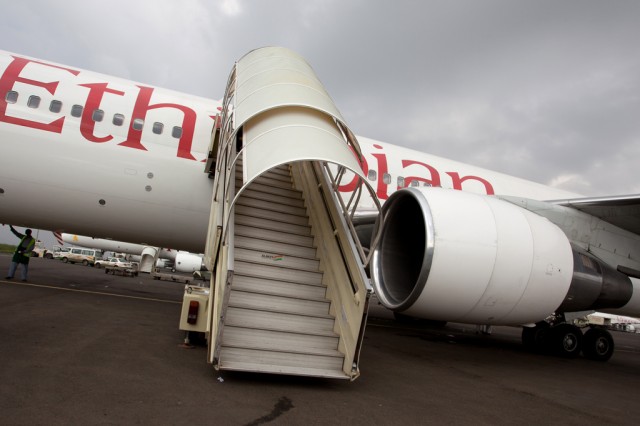
Boarding onto the Boeing 767-300ER to Jo'Burg. Photo by Jeremy Dwyer-Lindgren / NYCAviation.
Much like on the prior flight, the forward cabin staff were up and about serving drinks as passengers settled in for the five or so hour flight. We departed about 20 minutes late with a powerful and aggressive climb out from Bole (the airplane was probably only two’thirds full). The flight path had us tracking over a number of exotic locations through the African interior that, thanks to an aisle seat were largely unseen. About forty minutes into the flight a full drink service was offered along with little airplane shaped crackers, which I complemented with a delightful glass of Irish Cream.
Lunch began very quickly thereafter, and like the prior flight, the food matched expectations for business class. The hors d’oeuvre consisted of smoked salmon garnished with asparagus tips and sun dried tomato, turkey slices with red pepperoni and corn on the cob, and lamb terrine garnished with cherry tomato and dried prune. These were supplemented with a seasonal salad with fresh greens and an olive oil based vinaigrette along with bread and butter.
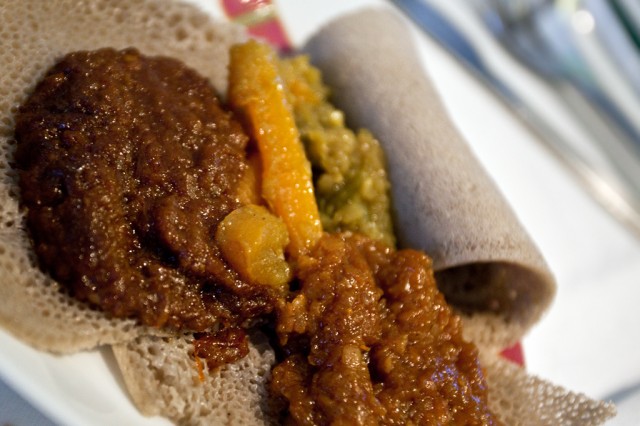
Ethiopian National Dish: Injera with Wot. Photo by Jeremy Dwyer-Lindgren / NYCAviation.
We were next served a course featuring the Ethiopian National Dishes. Each course came with a staple of Ethiopian meals known as injera. It is akin to flat bread though with a spongy texture and unusual taste. Atop the roll of injera one had the option of mixing and matching sampler sized portions of various stews (Wot) (though I would liken the consistency more to curry than stew). I chose to go with Doro Wot (spicy stew), Ataklet Wot (mixed vege), and Miser Wot (lentil’based). They were all quite enjoyable and doled out in such large portions that I actually thought this course was the main entree. It was not though, and the actual entree was a choice between beef, chicken, fish, and vegetable. I went with the beef in cumin sauce with basmati rice and sauted carrots along with an Ethiopian beer called St. George. The meal was enjoyable enough but I was already quite full from the previous two courses, and consequently I ended up not finishing it.
A nap was in order after the very filling meal service. Despite its age and appearance, the seat was quite comfortable. It reclines to a respectable 59 inches of pitch, which was enough to lend me a solid one hour nap. I didn’t have anyone seated next to me in the 2’2’2 configured cabin, so privacy wasn’t really an issue’“but had there been someone next to me I can’t say I would’ve been entirely comfortable taking a nap. The seat also features the standard tray in the armrest, audio jack, and is provided with a pillow and blanket. There was ample leg room. It may not be fancy, but it gets the job done. With an hour and a half remaining I caught some of the programming on the projector screen in front of me. The audio, provided by Ethiopian headphones, functioned just fine. The very large screen being only a few feet in front of me became a bit overwhelming to watch, but that was more a matter of location of my seat’“one row back would’ve made a big difference.
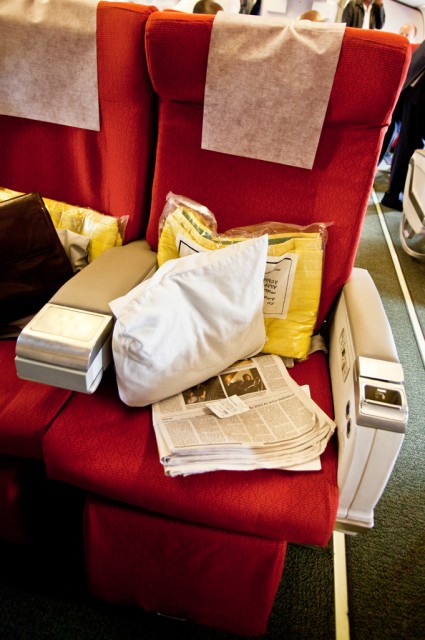
Cloud Nine Seat on ET-AMQ 767. Photo by Jeremy Dwyer-Lindgren / NYCAviation.
A care kit containing basic items like comb, toothpaste & brush was provided toward the end of the flight. It was nice to clean up a bit before landing and feel slightly more refreshed and ready for the day ’“ especially after you’ve been travelling for nearly 35 hours.
Final approach into OR Tambo was a bit rough, but that just made it fun. We touched down on time at 1315. Taxi was fairly quick and we pulled up to a gate flanked by a handful of Boeing 777s. Cloud Nine passengers deplaned first, allowing a quick and easy beeline to customs. With no competition in the customs line the entry process lasted a grand total of ten minutes. Bags, including mine, arrived about fifteen minutes later.
Part III The Bottom Line
We will take up Flight 809, service to Johannesburg, first. This one is a bit hard to judge. Looking at the schedules, the flight is operated by a mixture of aircraft; chiefly the Boeing 767-300ER (B767) and Boeing 757-200 (B757), though the carrier’s 737-700s are capable of performing the route as well. Like many airlines, cabin layouts and features vary within an individual type and Ethiopian is no exception. Consequently, experiences can differ from day to day depending on the plane. As a result, it seems worthwhile to distinguish and judge product and service separately.
In terms of product, flight 809 left a bit to be desired. This is almost entirely a result of the antiquated entertainment system. Most travelers on Ethiopian B767s will have a personal TV with a well stocked range of on-demand entertainment, but a handful will receive the retro-treatment. Charmingly nostalgic though it is for an aviation fan, most customers would likely feel it falls short of a competitive business class product on the international scene. On a five hour flight this is not really the end of the world, but many are used to having personalized entertainment options on these trans’continental flights. The seat appeared to be a bit dated as far as competing products go but was ultimately very comfortable with generous seat pitch.
Equally as important as product is service. In this respect, Ethiopian excelled on the flight. The food was good and plentiful, and those not familiar with Ethiopian fare will have an opportunity to sample something new and exciting. The cabin crew was professional and attentive.
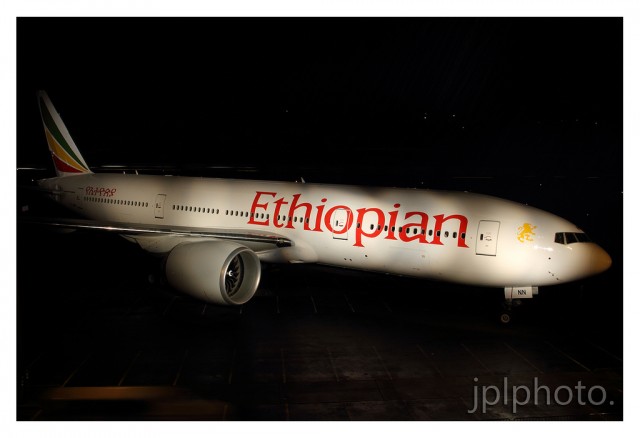
Ethiopian 777-200LR ET-ANN taken at Boeing Field in Seattle. Photo by Jeremy Dwyer-Lindgren / NYCAviation.
Taking up Flight 501, Ethiopian Airlines service to Washington Dulles is not new, but it certainly feels as though it is. The introduction of the new B777’200LRs to replace the previously utilized B767’300ERs is a serious upgrade to the route on many levels, the least of which is the inbound leg becoming a true non’stop. Boeing 777’based Cloud Nine class represents a big step up for Ethiopian and a presents a true competitive product on the international market, particularly for an African based carrier. The fresh cabin and modern product does not disappoint. Customers flying this route (or the outbound Flight 500) will find friendly and fast on board service, enjoyable food, a good seat, and quality on-demand entertainment options.
Overall in terms of service, the verdict on Cloud Nine is pretty easy: good. Cabin crews on both flights were attentive, friendly, and professional. Food was plentiful, warm, and good quality. The only inconsistency was not having served the Ethiopian National dishes on flight 501, though the airline points out that serving the meals require traditional preparation, cooking, and serving procedures which require time and care.
It is reasonable to say, however, that business class can be a bit varied in terms of product. On the one hand the B767 cabin on Flight 809 appeared to represent a business class of days gone by. On the other, the B777 cabin on Flight 501 represented a modernized, competitive product of today. The airline has told NYCA that they intend to upgrade seven Cloud Nine cabins aboard the B767, a welcome step toward ironing out the inconsistent product in their B767 fleet. Looking to the very near future, the airline is anticipating delivery of their first Boeing 787 Dreamliner in the summer of 2012. No doubt the new cabin aboard their Dreamliners will continue to build upon the successful choices made on their B777-type business cabins.
When the upgrades and fresh aircraft meet up with the already solid in-flight service, the future is even brighter for Cloud Nine. If a trip to Addis or elsewhere in Africa is in your future, flying aboard Ethiopian Airline Cloud Nine is a choice that will serve you well, both now and into the future.

Ethiopian
- Ethiopian DC3 taken in 1973. Photo by Christian Hanuise via Wikipedia
On December 13th, Ethiopian Airlines was welcomed into the Star Alliance. This is just one of quite a few major steps that the African airline has taken in recent years.
The airline started operations in 1946 and is the flag carrier of Ethiopia. It is currently owned 100% by the government and has grand plans for the next few years, which they call, “Vision 2025.” Their vision is not only to grow the airline, but to, “contribute positively to socio economic development of Ethiopia in particular and the countries it operates in general by undertaking its corporate social responsibilities and providing vital global air connectivity.”
In November 2010, the airline took delivery of their first Boeing 777 and they currently operate a fleet of five of the wide bodied aircraft. They aren’t stopping with just 777s, they are looking to the future and have orders for ten Boeing 787s and 12 Airbus A350s. Joining the Star Alliance is just one step in Ethiopian Airlines becoming more of a global player.
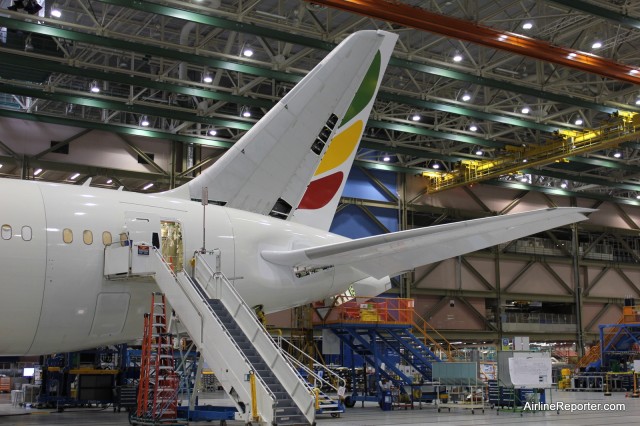
A far cry from the DC-3: Ethiopian Airlines first 787 Dreamliner on the Boeing Factory Floor in Sept 2011.
“It is another historical milestone for Ethiopian to join this most prestigious and longest serving Alliance in the world,”said Tewolde Gebremariam, CEO Ethiopian Airlines via a press release. “This day will remain colourfully marked in our history book. It is in line with our efforts to lay a strong foundation for the airline to achieve its vision 2025 objectives.”
If you like the airline, do not waste your time just buying a model. They are actually selling three Boeing 757-200ERs via their website right now. Talk about a great gift for the holidays!
Want a bit more? My friend and NYCAviation.com writer Jeremy Dwyer-Lindgren recently took some flights on Ethiopian and reviewed their business class (cloud nine) and economy class products.
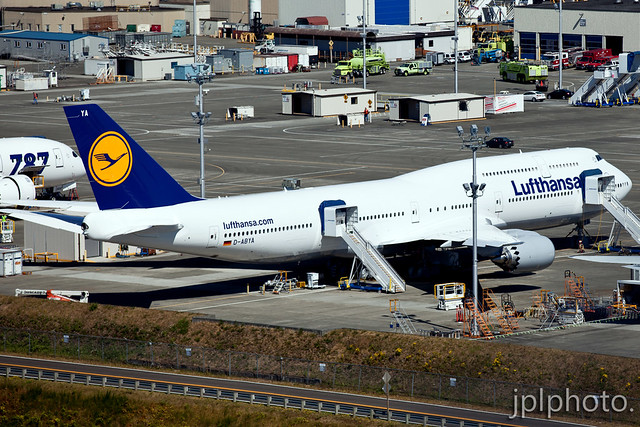
While catching a ride in a Boeing Stearman, Seattle Photographer and NYCAviation Chief Correspondent Jeremy Dwyer-Lindgren got a nice shot of the first Boeing 747-8 Intercontinental in full Lufthansa livery. Previously, we have seen another 747-8I in partial Lufthansa livery, missing her titles and logo. Interestingly, the registration number, D-ABYA, was used on Lufthansa’s very first Boeing 747-100 delivered on October 3, 1970. According to Lufthansa, the registration was created based on a specific pattern set for the airline. D represents Duetschland, A stands for an aircraft weighing over 20 tons, B is for Boeing, the Y stands for the aircraft type (V is the designation for the 747-400) and the final letter represents the actual aircraft and since this is the first to get a Lufthansa registry, it is A. According to the airline a name for the first 747-8 Intercontinental has not yet been decided.
Recently, the Boeing 747-8 Freighter won certification from the Federal Aviation Administration (FAA) and Boeing is set to deliver the first 747-8F to Cargolux on September 19th and the second on the 21st. The 747-8I is still under going flight testing and the first is expected to be delivered to a private customer sometime later this year. Lufthansa is expected to take delivery of their first Intercontinental sometime in early 2012.
I am a fan of the simplistic Lufthansa livery, but if you are wondering what a retro scheme might look like on the 747-8 Intercontinental, someone has already done a mock up. I was able to find some additional photos of Lufthansa’s full-liveried 747-8I on Lufthansa’s website taken by Boeing. Click any for larger:
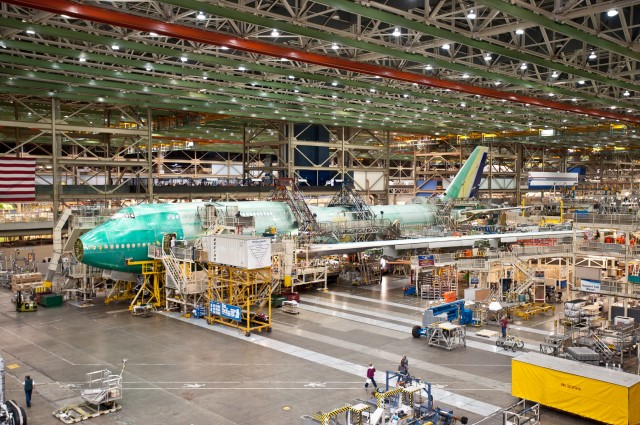
Lufthansa's Boeing 747-8 Intercontinental inside the Boeing Factory.
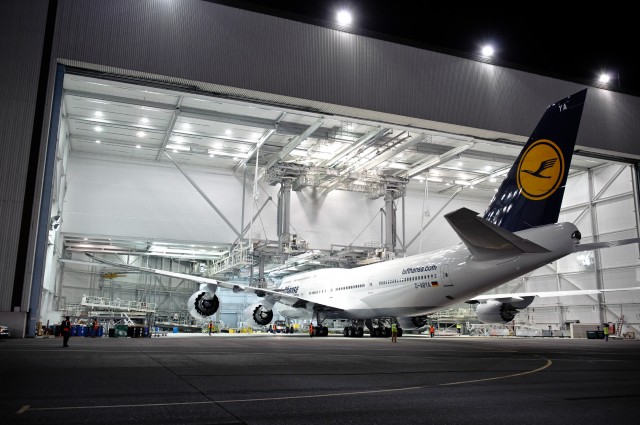
Lufthansa 747-8I paint hangar roll out
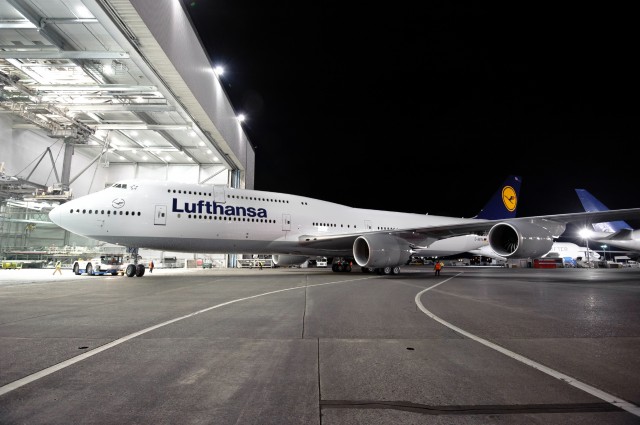
A full liveried 747-8I rolls out of the paint hangar overnight.
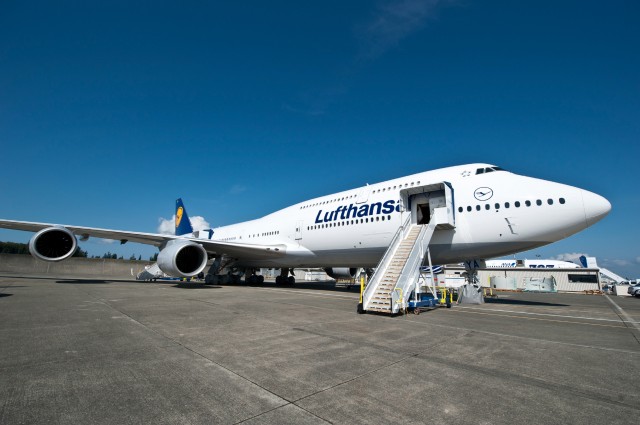
A Lufthansa Boeing 747-8I sits on the flight line at Paine Field.
This post was updated with additional photos and information.























